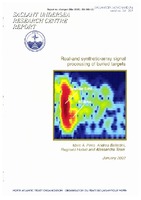| dc.contributor.author | Pinto, Marc A. | |
| dc.contributor.author | Bellettini, Andrea | |
| dc.contributor.author | Hollett, Reginald D. | |
| dc.contributor.author | Tesei, Alessandra | |
| dc.date.accessioned | 2018-10-11T14:09:13Z | |
| dc.date.available | 2018-10-11T14:09:13Z | |
| dc.date.issued | 2002/01 | |
| dc.identifier | 13431 | |
| dc.identifier.govdoc | SM-389 | |
| dc.identifier.uri | http://hdl.handle.net/20.500.12489/577 | |
| dc.description.abstract | Results from two field experiments aimed at investigating the detection and classification of buried targets are presented. In both experiments a 2-16 kHz parametric source was used. In the first experiment the source was used in combination with a 12 m horizontal line array and in the second with a 1.4 m vertical line array which was displaced horizontally along an underwater rail to form a 10 m x 1.4 m two dimensional synthetic aperture sonar (SAS). To increase the SAS integration time, the parametric source was electronically scanned in azimuth during the displacement along the rail, as in spotlight mode. It is shown that both arrays allow important signal to reverberation gains, enhancing the detection of sub-bottom echoes. A new, environmentally adaptive, matched filter which further improves the signal to reverberation ratio while allowing discrimination between proud and buried targets is presented and validated experimentally. The use of resonant scattering for target classification ofburied objects is discussed, in the particular case of spherical shells. | |
| dc.format | vi, 21 p. : ill. ; 14 fig. | |
| dc.language | English | |
| dc.publisher | NATO. SACLANTCEN | |
| dc.subject | Buried objects detection | |
| dc.subject | Target classification | |
| dc.subject | Synthetic Aperture Sonar (SAS) | |
| dc.subject | Target scattering | |
| dc.subject | Target detection | |
| dc.title | Real-and synthetic-array signal processing of buried targets | |
| dc.type | Scientific Memorandum (SM) | |
